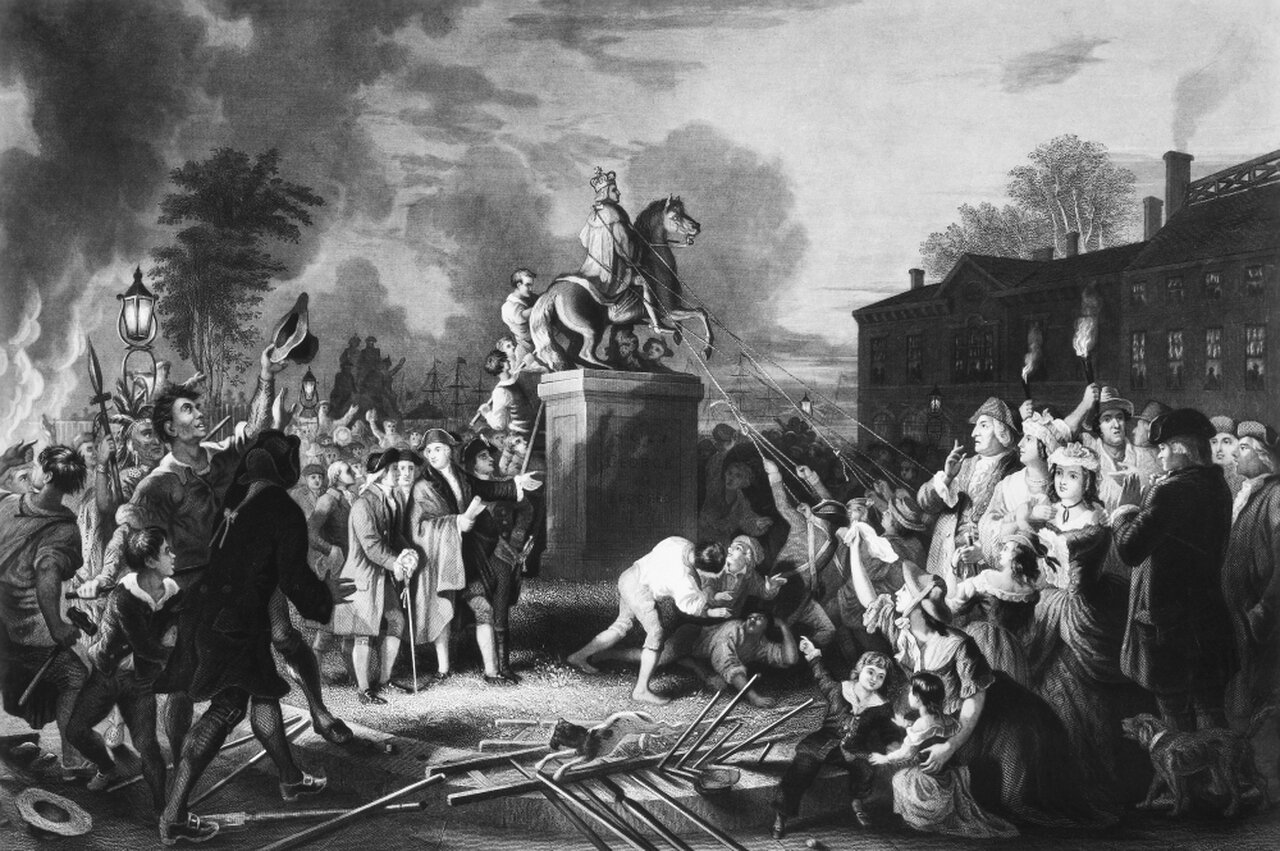Who Tore It Down?
by Dylan Giacobbe
Communications & Marketing Intern Dylan Giacobbe explores the scene depicted in Pulling Down the Statue of George III, detailing who is pictured and who isn’t.
The Fourth of July, or Independence Day, is perhaps the most foundational national holiday in the United States -- a celebration of American severance from the monarchical rule of Great Britain. While we remember July 4 as the day the Declaration of Independence was presented, the American people during 1776 did not receive information about the Declaration so quickly. For people across the different states, their rallying days came when the news reached them. One such day of revelation came on July 9 in Bowling Green, New York, a day marked for its riotous and symbolic response to the Declaration amid the ongoing Revolutionary War.
Tearing down the statue of george iii, John c. Mcrae (1859)
Engraving
1915.04.001
Fraunces Tavern Museum, Gift of Mrs. Charles P. Wilbour, 1915
This engraving depicts the excited crowd at work toppling the statue of George III that was erected in Bowling Green From Revolution and the City exhibit: "After the declaration was read to the troops, the soldiers were supposed to return to their quarters, but some undoubtedly joined the excited mob of New York City citizens that celebrated with a rampage through the city's streets. Windows of known Loyalists were broken, and the crowd escalated in violence until they found themselves at Bowling Green, at the Statue of George III that had been erected only 10 years earlier in honor of the repeal of the Stamp Act. The statue, for which the New York General Assembly had paid 1,000 pounds sterling and had been shipped from England, stood on a 15-foot high marble pedestal. The crowd toppled the statue - horse and king - and by some accounts put the King's head on a pike and paraded it through the city. British soldiers retaliated by mutilating a statue of William Pitt, a hero to Americans because of his support of the colonists."
Who were the people in this mob and what brought them to take such drastic and destructive measures to show support for the Revolution? Most of those who participated in the toppling of the statue were not people looking to simply incite violence under mob mentality, they were, instead, people of lower classes and statuses who found no other outlet to express their feelings towards British rule. Not many people possessed the means to actively support the Revolution through money, writing, or politics, so they instead resorted to protest to convey this support.
John C. McRae, the man who engraved this piece in 1859, evoked this sentiment of the underserved members of American society at the time as participating in this powerful, patriotic moment. The original painting of the event by Johannes A. Oertel, upon which this engraving is based, features both a Native American family as well as an African American man prominently in front of the pedestal. Despite the engraving downplaying these inclusionary depictions in many ways (such as obscuring the Native Americans), the piece serves to show common and less privileged folk along with continental soldiers showing their revolutionary attitudes.
The destruction of the statue by soldiers and patriots acted as a declaration in its own right, one that abandoned formality and forwent ink on parchment. For those in Bowling Green on July 9, 1776, severing ties was not simply a proclamation; for as the gilded lead statue of the distant king fell, revolution and an independent America were a bold and steadfast assertion. The engraving is a testament not only to rebellion against a ruler, but also to the power of protest as a means of providing a voice to those who may not otherwise have a platform to express their feelings.
References
D'Costa, Krystal. “The History behind the King George III Statue Meme.” Scientific American Blog Network, Scientific American, 23 Aug. 2017, blogs.scientificamerican.com/anthropology-in-practice/the-history-behind-the-king-george-iii-statue-meme/.
“Museum Collections.” New-York Historical Society | Pulling Down the Statue Of King George III, New York City, www.nyhistory.org/exhibit/pulling-down-statue-king-george-iii-new-york-city.
“Pulling Down the Statue of George III.” Pulling Down the Statue of George III | Teach US History, www.teachushistory.org/american-revolution/resources/pulling-down-statue-george-iii.
“William Walcutt: ‘Pulling Down the Statue of George III at Bowling Green, N.Y. July 9, 1776.".” Art Galleries, galleries.lafayette.edu/2019/01/02/william-walcutt-pulling-down-the-statue-of-george-iii-at-bowling-green-n-y-july-9-1776/.






